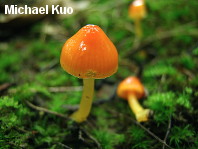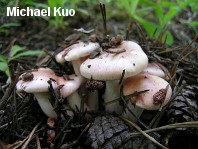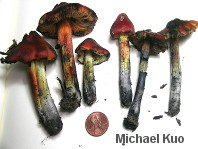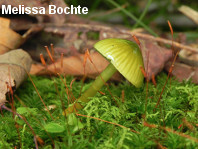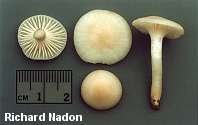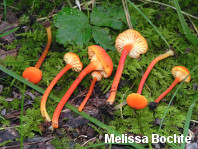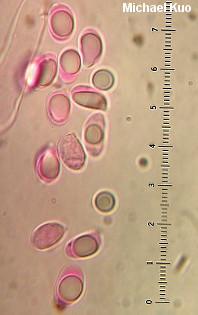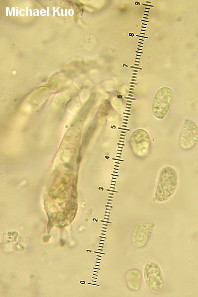Key to 131 North American Waxy Caps 
| 1. | Cap, gills, and stem bruising and discoloring black; cap conic to broadly conic. | 2 |
| 1. | Mushroom not blackening; cap variously shaped. | 4 |
| 2. | Growing in sand dunes; gills becoming salmon to red before blackening. | Hygrocybe conicoides |
| 2. | Growing in hardwood and conifer forests; gills not becoming salmon to red. | 3 |
| 3. | Fresh stem slimy to sticky. | |
| 3. | Fresh stem dry or slightly greasy. | |
| 4. | Cap whitish to grayish, with blue shades near the margin; gills, stem, and flesh bluish; found in western North America under conifers. | |
| 4. | Cap not as above; gills, stem, and flesh not bluish; variously distributed. | 5 |
| 5. | Young cap green or blue, maturing to reddish, orange or yellow; stem slimy when fresh. | 6 |
| 5. | Young cap not green or blue--or, if green, then stem dry to greasy but not slimy; if cap is not green, stem may be slimy or not. | 7 |
| 6. | Widely distributed in North America; young cap green; mature cap orange to yellow; basidia up to 45 µ long. | |
| 6. | Found in coastal California; young cap blue; mature cap red, eventually fading to yellow; basidia up to 60 µ long. | |
| 8. | Stem usually yellow except at apex; known from the Caribbean and Mexico; spores dimorphic (13-20 x 7-10 µ and 5-7 x 3-4 µ). | |
| 8. | Stem usually more green than yellow; known from the Caribbean, Mexico, and the West Coast of the United States; spores 8-10 x 5.5-6.5 µ. | |
| 9. | Fresh cap white, whitish, buff, very pale brownish, or very pale orangish. | 10 |
| 9. | Fresh cap more highly colored. | 43 |
| 10. | Stem dry to moist or greasy when fresh. | 11 |
| 10. | Stem sticky to slimy or glutinous when fresh. | 33 |
| 11. | Odor distinctive (slice flesh and wait at least 10 minutes). | 12 |
| 11. | Odor not distinctive. | 16 |
| 12. | Odor reminiscent of almonds; stem discoloring yellow where handled; under hardwoods; known from Michigan. | |
| 12. | Odor not reminiscent of almonds; stem not yellowing; variously distributed and associated. | 13 |
| 13. | Odor reminiscent of cedar. | |
| 13. | Odor not reminiscent of cedar. | 14 |
| 14. | Odor sickly sweet, strong; found under beech and other hardwoods east of the Rocky Mountains in late spring; cap usually orangish but sometimes nearly whitish when faded. | |
| 14. | Odor aromatic, or reminiscent of anise or peaches, not strong; found under conifers in Western North America in late summer and fall. | 15 |
| 15. | Gills pinkish throughout development; odor reminiscent of peaches; cap evenly colored at maturity. | |
| 15. | Gills white, at least at first; odor reminiscent of anise; cap developing a yellowish to brownish center at maturity. | |
| 16. | Growing near melting snowbanks in western mountains; cap normally pink to pinkish but sometimes fading to whitish; gills pinkish; spores 12-15 µ long. | |
| 16. | Not growing near snowbanks; variously distributed; gills variously tinted; spores shorter than 12 µ. | 17 |
| 17. | Fresh cap dry to moist or lubricous; pileipellis not gelatinized. | 18 |
| 17. | Fresh cap sticky to slimy; pileipellis an ixocutis or ixotrichoderm. | 25 |
| 18. | Gills notched; taste bitter; fusoid hymenial cystidia present; spores 5-6.5 µ long; known from the southeastern United States and Trinidad. | |
| 18. | Gills broadly attached or running down the stem; taste not distinctive; hymenial cystidia absent; spores variously sized; variously distributed. | 19 |
| 19. | Gills pale yellow; mature cap 1-3 cm across; spores 5-7 x 3.5-4.5 µ. | |
| 19. | Gills white to ivory; spores variously sized. | 20 |
| 20. | Gills close; stem fairly thick (1-2 cm); spores subglobose or nearly so. | |
| 20. | Gills distant or nearly distant; stem width varying; spores ellipsoid to lacrymoid (subglobose in one species that features a narrow stem). | 21 |
| 21. | Fresh cap moist to lubricous. | 22 |
| 22. | Found under conifers or hardwoods; fairly widely distributed in North America; spores 7-9 µ long. | |
| 22. | Found under hardwoods; known from Michigan; spores 6-7 µ long. | |
| 23. | Gills nearly distant, broadly attached to the stem or just beginning to run down it; mature cap 1-2.5 cm across; spores 4-5.5 µ long. | |
| 23. | Gills distant, running down the stem; mature cap 2-10 cm across; spores 5.5-10 µ long. | 24 |
| 24. | Stem under 1 cm thick; spores 8-10 µ long. | |
| 24. | Stem 0.5-2 cm thick; spores 5.5-6.5 (-8) µ long. | Cuphophyllus pratensis var. pallidus |
| 25. | Found east of the Rocky Mountains. | 26 |
| 25. | Found from the Rocky Mountains westward. | 29 |
| 26. | Stem usually under 1 cm thick at maturity. | 27 |
| 26. | Stem 1-2 cm thick at maturity. | 28 |
| 27. | Associated with spruces; gills broadly attached to the stem or running down it; recorded in eastern North America from Nova Scotia to Michigan. | |
| 27. | Associated with aspen or birch; gills notched; recorded only from Michigan. | |
| 28. | Appearing in pine-oak woods over winter in Gulf Coast states; spores 3-4 µ wide. | |
| 28. | Appearing in oak forests in summer and fall throughout eastern North America and the Midwest; spores 4-5.5 µ wide. | |
| 29. | Stem 15-40 mm thick; fibrillose veil usually leaving a sheath with a folded-over, ring-like belt on the stem; usually found near melting snowbanks. | |
| 29. | Stem under 15 mm thick; veil absent; not usually found near melting snowbanks. | 30 |
| 30. | Gills pinkish throughout development; stem 10-20 mm thick. | |
| 30. | Gills white, at least at first; stem 3-12 mm thick. | 31 |
| 31. | Not typically growing in clusters; gills remaining white. | 32 |
| 32. | Cap evenly snow white. | |
| 32. | Cap developing a yellowish to brownish center. | |
| 33. | Cap conic to broadly conic; gills narrowly attached; stem base bruising pinkish red. | |
| 33. | Cap convex to broadly convex, flat, or shallowly depressed; gills broadly attached or running down the stem; stem base not bruising red. | 34 |
| 34. | Cap white; cap margin with yellow granules, at least when young; surfaces turning yellow with KOH; found under conifers. | |
| 34. | Cap white or not; margin without yellow granules; KOH reaction yellow or not; found under hardwoods or conifers. | 35 |
| 35. | Stem fairly stocky (10-30 mm thick at maturity). | 36 |
| 35. | Stem slender (2-15 mm thick at maturity). | 39 |
| 36. | Cap and stem cleanly white throughout development; cortina-like partial veil present on very young specimens. | |
| 36. | Cap and/or stem usually developing yellowish to orangish or brownish shades with maturity; cortina-like veil not present in young specimens. | 37 |
| 37. | Stem featuring a glutinous "slime ring" when young and fresh; found under conifers (usually pines); cap usually tinted slightly yellowish; widely distributed in North America. | |
| 37. | Stem slimy to glutinous but not featuring a slime ring; cap yellowish or not; found under hardwoods or conifers; distributed east of the Rocky Mountains. | 38 |
| 38. | Stem with a thin fibrillose sheath underneath the gluten; cap evenly yellowish to pinkish buff at first, becoming orangish; spores 8-11 µ long. | |
| 38. | Stem glutinous but without a fibrillose sheath; cap whitish with a brownish center when young; spores 5.5-8 µ long. | |
| 39. | Odor strong and fragrant to unpleasant; cap and stem becoming pinkish with age. | |
| 39. | Odor not distinctive; cap and stem not becoming pinkish. | 40 |
| 40. | Gills becoming brownish with age and drying reddish brown for the herbarium; associated with American beech, east of the Great Plains. | |
| 40. | Gills not becoming brownish nor drying reddish brown; variously associated and distributed. | 41 |
| 41. | Stem featuring a fibrillose ring; spores 10-14 µ long; apparently rare; recorded only from the Mt. Hood and Mt. Shasta areas. | |
| 41. | Stem without a fibrillose ring; spores 6-10 µ long; commonly collected; variously distributed. | 42 |
| 42. | Cap becoming yellowish with age; stem featuring tiny reddish brown points when dried; spores 8-10 µ long. | |
| 42. | Cap remaining white; stem not featuring reddish brown points when dried; spores 6-9 µ long. | |
| 43. | Cap red, orange, yellow, or pink. | 44 |
| 43. | Cap brown, black, gray, purplish gray, olive, brownish, or tan. | 102 |
| 44. | Cap convex, bell-shaped, flat, or centrally depressed. | 50 |
| 45. | Cap pink to pinkish orange; gills pink; pleuro- and cheilocystidia present. | |
| 45. | Cap red, orange, or yellow; gills not pink; cystidia absent. | 46 |
| 46. | Cap orange to yellow. | 48 |
| 47. | Stem dry; spores 10-14 µ long. | |
| 47. | Stem sticky to slimy; spores 7-9 µ long. | |
| 48. | Gills remaining bright orange throughout development, contrasting with the mature cap color; cap usually broadly conic rather than sharply conic (and usually only so when young); cap dry to moist; stem surface smooth; pileipellis a cutis. | |
| 48. | Gills not as above; cap broadly or sharply conic; cap sticky to slimy; stem surface becoming fibrillose to stringy with age; pileipellis an ixocutis. | 49 |
| 49. | Cap broadly conic, sticky to slimy; spores 8-10 µ long, often constricted. | |
| 49. | Cap sharply conic, sticky when young but soon dry; spores 9-12 µ long, not constricted. | |
| 50. | Fresh stem sticky to slimy. | 51 |
| 50. | Fresh stem dry to greasy or moist. | 64 |
| 51. | Fresh cap red to orange (possibly fading to yellow in old age). | 57 |
| 52. | Cap yellow over the center only (elsewhere whitish); dried caps becoming orangish; spores 6-8 µ long. | |
| 52. | Cap evenly yellow overall; dried cap colors varying; spore length varying. | 53 |
| 53. | Gills narrowly attached; fresh stem merely sticky. | |
| 53. | Gills broadly attached or running down the stem; fresh stem slimy. | 54 |
| 54. | Stem white when fresh and young; known only from northern California. | |
| 54. | Stem yellow when fresh and young (possible fading to whitish in old age); variously distributed. | 55 |
| 55. | Gill edges often gelatinized; spores very broadly ellipsoid to nearly subglobose. | |
| 55. | Gill edges not gelatinized; spores more narrow than above. | 56 |
| 56. | Found in alpine and arctic areas; spores 4.5-6 µ wide, variously shaped but not usually constricted. | |
| 56. | Not found in alpine or arctic areas; spores 3-5 µ wide, usually constricted. | |
| 57. | Cap 4-15 cm across, rusty orange; stem 0.5-2 cm thick; under oaks and other hardwoods in eastern North America. | |
| 57. | Cap smaller (often much smaller) than above, variously colored; stem more slender than above; ecology and distribution varying. | 58 |
| 58. | Cap dull pinkish orange to dull brownish orange (occasionally with grayish or olive shades mixed in); odor often, but not always, fishy or reminiscent of burned rubber; gill edges often gelatinized; filamentous cheilocystidia present. | |
| 58. | Cap a brighter shade of orange or red; odor not distinctive; gill edges not gelatinized; cheilocystidia absent. | 59 |
| 59. | Stem fairly sturdy (4-10 mm thick or more), white (though sometimes discolored by orange gluten), and stuffed; found under conifers; lamellar trama divergent. | |
| 59. | Stem more flimsy than above (1-3 mm thick), colored, often hollowing; habitat varying; lamellar trama parallel. | 60 |
| 60. | Gills running down the stem or beginning to do so (decurrent to subdecurrent); cap orange. | |
| 60. | Gills broadly to narrowly attached to the stem, but not running down it (adnate to adnexed); cap orange or red. | 61 |
| 61. | Taste bitter; spores often constricted to contorted. | |
| 61. | Taste not distinctive; spores more regularly ellipsoid. | 62 |
| 62. | Cap orange; appearing in spring or early summer. | |
| 62. | Cap red; appearing in summer and fall. | 63 |
| 63. | Possibly widespread in North America; spores 7–10 µm long. | |
| 63. | Known from Florida; spores 5–7 µm long. | |
| 64. | Growing near melting snowbanks in western mountains; cap pink to pinkish but sometimes fading to whitish; gills pinkish; spores 12-15 µ long. | |
| 64. | Not growing near snowbanks; variously distributed; cap color varying; gills variously tinted; spores variously sized. | 65 |
| 65. | Gills becoming spotted with pink and red, eventually discoloring pink to red overall; mushroom medium-sized to large at maturity (cap over 3 cm across, stem 0.5-2 cm wide) and often similar in stature to a russula; cap pink to red or purplish red--often streaked, mottled, or granulated in appearance. | 66 |
| 65. | Gills not becoming spotted with pink or red; mushroom small to large; stature varying; cap variously colored. | 70 |
| 66. | Associated with oaks and other hardwoods; gills close. | |
| 66. | Associated with conifers; gills close or nearly distant. | 67 |
| 67. | Taste strongly bitter; cap readily bruising and discoloring yellow. | |
| 67. | Taste not distinctive; cap not bruising yellow, or doing so slowly and faintly. | 68 |
| 68. | Gills distant or nearly so; stem 0.5-1 cm thick; veil absent. | 69 |
| 69. | Mature cap mottled pink to reddish over a whitish ground; stem and cap sometimes bruising yellow; gills long remaining whitish; spores 8-10 µ long. | |
| 69. | Mature cap more evenly reddish to pink; surfaces never yellowing; gills soon reddish; spores 6.5-8 µ long. | |
| 70. | Growing in sand dunes along the Gulf Coast, in association with sandhill rosemary shrubs (Ceratiola ericoides); cap orange to red, often with a brownish center; spores 15-20 µ long. | |
| 70. | Not growing in sand dunes with rosemary shrubs; variously distributed; cap color varying; spores < 15 µ long (2 exceptions). | 71 |
| 71. | Gills lavender to dull purple; cap brownish orange to orange; recorded from the southern Appalachians to Massachussetts. | |
| 71. | Gills not lavender to purple; cap color varying; variously distributed. | 72 |
| 72. | Cap orange to yellow-orange, fading to pale orange or yellowish, moist, often slightly bell-shaped; gills bright orange and remaining so (contrasting starkly with the cap and stem in maturity); stem 40-100 x 3-6 mm, bald, moist to dry. | |
| 72. | Cap various shades of orange, yellow, pink, and red, convex to broadly bell-shaped or flat; gills not usually contrasting starkly with cap and stem at maturity; stem varying. | 73 |
| 73. | Odor distinctive (sometimes best determined after several specimens have been placed in a closed container for a while). | 74 |
| 73. | Odor not distinctive. | 79 |
| 74. | Odor of garlic; cap small (usually under 2 cm), red to orangish red, somewhat scaly. | Hygrocybe helobia |
| 74. | Odor not garlic-like; cap varying. | 75 |
| 75. | Odor like rotten eggs or swamp gas; cap yellow and broadly bell-shaped. | |
| 75. | Odor not like rotten eggs; cap not yellow, variously shaped. | 76 |
| 76. | Odor of honey, best detected as specimens are drying or in dried specimens; cap bright orange. | |
| 76. | Odor not reminiscent of honey; cap pale orange to pale pinkish orange or pinkish. | 77 |
| 77. | Recorded from the West Coast; cap pinkish; odor sickening and strongly sweet. | |
| 77. | Variously distributed; cap pale orange to pale pinkish orange; odor sickening and sweet or not. | 78 |
| 78. | Under conifers; odor distinctive but hard to describe: fragrant, soapy, slightly foul; spores 7-10 µ long. | |
| 78. | Under hardwoods; odor strong and unpleasant, reminiscent of the "coal tar" odor in some species of Tricholoma; spores 5-7 µ long. | |
| 79. | Cap dull to bright yellow. | 80 |
| 80. | Fresh cap dry to moist or greasy. | 81 |
| 80. | Fresh cap sticky to slimy. | 82 |
| 81. | Cap dull yellow to yellowish, with fine brownish to blackish scales; stem colored like the cap; often growing in clusters. | |
| 81. | Cap dark yellow, bald; stem becoming pink to red near the base; not usually clustered. | |
| 82. | Gills narrowly attached to notched. | |
| 82. | Gills broadly attached to the stem or running down it. | 83 |
| 83. | Spores 4-5 µ wide; stipitipellis with some gelatinized elements. | |
| 83. | Spores 2.5-3.5 µ wide; stipitipellis not gelatinized. | |
| 84. | Cap dull brownish orange, fading to pale orange or buff, usually appressed-fibrillose; stem 0.5-1.5 cm thick; spores subglobose or very broadly ellipsoid; lamellar trama interwoven. | |
| 84. | Cap more brightly colored than above (bright orange to red), bald to appressed fibrillose or scaly; stem width varying; spores varying; lamellar trama parallel. | 85 |
| 85. | Cap surface scurfy to scaly, at least over the center (use a hand lens). | 86 |
| 85. | Cap surface basically bald. | 94 |
| 86. | Odor of garlic; fresh cap bright red; spores 8-10 µ long. | Hygrocybe helobia |
| 86. | Odor not distinctive; fresh cap red or orange; spore size varying. | 87 |
| 87. | Gills narrowly attached to the stem, or attached by a notch; cap red and tiny (only up to 1 cm across); known from the Gulf Coast. | |
| 87. | Gills broadly attached to the stem or running down it; cap color and size varying; distribution varying. | 88 |
| 88. | Tips of scales on cap surface brown to brownish or blackish; growing in moss or sphagnum. | 89 |
| 88. | Tips of scales not brown to brownish or blackish; habitat varying. | 90 |
| 89. | Fresh cap orange to yellow. | Hygrocybe turunda |
| 89. | Fresh cap red. | Hygrocybe coccineocrenata |
| 90. | Associated with sweet bay in the Gulf Coast region; cap color variable but usually involving red mixed with olive and/or brown; pileipellis two-layered. | |
| 90. | Variously distributed; cap without olive or brown shades; pileipellis not not-layered. | 91 |
| 91. | Mature cap 0.5-2 cm across. | 92 |
| 91. | Mature cap 2-7 cm across. | 93 |
| 92. | Gills running far down the stem; cap densely (but finely) scaly; spores 9-12 µ long. | |
| 92. | Gills broadly attached to the stem or just beginning to run down it; cap merely scurfy; spores 5-8 µ long. | |
| 93. | Cap red; known from Tennessee and North Carolina; cystidia present; spores 11-17.5 µ long. | |
| 93. | Cap orange; known from eastern North America and from Washington; spores 5-8 µ long. | |
| 94. | Gills at maturity narrowly attached to the stem, or attached by a notch. | 95 |
| 94. | Gills at maturity broadly attached to the stem, or running down it. | 98 |
| 95. | Cap with a central hump or point. | 96 |
| 96. | Cap surface soon dry; gills deep orange and remaining so into maturity, contrasting with faded cap. | |
| 96. | Cap surface sticky; gills yellow to pale orange, not as above. | |
| 97. | Cap 2-10 cm across; stem surface becoming fibrillose to stringy with maturity; stem 6-20 mm thick. | |
| 97. | Cap 3-6 cm across; stem surface not becoming fibrillose to stringy; stem 3-6 mm thick. | |
| 98. | Fresh, mature cap red. | 99 |
| 98. | Fresh, mature cap orange (but cap possibly red when very young and moist). | 100 |
| 99. | Cap 2-6 cm across, dry. | |
| 99. | Cap 0.5-1 cm across, sticky. | |
| 100. | Mature cap 2-3.5 cm across; odor of honey (best detected as specimens are drying or in dried specimens). | |
| 100. | Mature cap 0.5-2 cm across; odor not distinctive. | 101 |
| 101. | Gills at maturity running deeply down the stem; cap surface sticky; stem 1-2 mm thick. | |
| 101. | Gills at maturity broadly attached to the stem or just beginning to run down it; cap surface dry; stem 2-5 mm thick. | |
| 102. | Fresh stem sticky to slimy. | 103 |
| 102. | Fresh stem dry to greasy or moist. | 117 |
| 103. | Odor strong, reminiscent of almonds. | 104 |
| 103. | Odor not distinctive, or at least not reminiscent of almonds. | 105 |
| 104. | Known from the West Coast; cap reddish brown to cinnamon brown, 4-7 cm across. | |
| 104. | Known from eastern North America; cap grayish brown to gray, 2.5-4 cm across. | |
| 105. | Mature stem 2-5 mm thick; cap relatively thin-fleshed; lamellar trama parallel. | 106 |
| 105. | Mature stem 5-30 mm thick; cap relatively fleshy; lamellar trama divergent. | 108 |
| 106. | Cap grayish to purplish gray when young (but later usually orangish); odor often, but not always, fishy or reminiscent of burned rubber; gill edges often gelatinized; filamentous cheilocystidia present. | |
| 106. | Cap brown to tan, gray, or black; odor not distinctive; gill edges not gelatinized; cheilocystidia absent. | 107 |
| 107. | Cap brown to purplish brown, fading to tan; gills yellowish to yellow; stem pale grayish, becoming yellowish. | |
| 107. | Cap black to dark grayish brown or dark gray; gills white to pale gray; stem colored like the cap. | |
| 108. | Cap reddish brown, tawny, cinnamon brown, or orangish brown. | 109 |
| 108. | Cap brown to yellow brown, olive brown, grayish brown, gray, or black. | 110 |
| 109. | Associated with hardwoods; young cap whitish with a reddish brown center; mature cap sometimes tawny to cinnamon brown overall, with a pale margin. | |
| 109. | Associated with conifers; cap fairly evenly reddish brown throughout development. | |
| 110. | Cap brown over the center but yellow brown to yellow near the margin; stem yellow to yellowish; associated with two-needled pines. | |
| 110. | Cap colors not as above; stem not yellow; associated with various trees. | 111 |
| 111. | Stem with a brown, appressed-fibrillose covering (underneath the gluten) that often becomes stretched out and streaked, or chevron-like, with age. | |
| 111. | Stem white to whitish or, with age, slightly brownish to grayish as the gluten dries out; bald, dotted, or fibrillose. | 112 |
| 112. | Stem apex with dot-like points that darken to brown or gray as the mushroom matures (and on dried specimens), contrasting with the stem surface. | |
| 112. | Stem apex bald or with pale dot-like points that do not darken as above. | 113 |
| 113. | Stem with a whitish, appressed-fibrillose covering (underneath the gluten); cap grayish; spores 9-13 µ long. | |
| 113. | Stem bald or, near the apex, dotted, but lacking a fibrillose covering; cap some shade of brown; spores varying in length. | 114 |
| 114. | Spores shorter than 10 µ. | 115 |
| 114. | Spores longer than 10 µ. | 116 |
| 115. | Under conifers; cap evenly dark olive brown to blackish. | |
| 115. | Under hardwoods; cap brown to grayish brown over the center, but much paler toward the margin. | |
| 116. | KOH orange to yellow on stem apex; most spores 10-15 µ long. | |
| 116. | KOH reaction on stem apex not recorded; most spores 12-18 µ long. | |
| 117. | Gills staining and bruising slowly pink; cap gray brown to gray or black. | 118 |
| 117. | Gills not staining or bruising pink; cap variously colored. | 119 |
| 118. | Spores round or nearly so; cylindric to subfusoid hymenial cystidia present. | |
| 118. | Spores ellipsoid; hymenial cystidia absent. | |
| 119. | Odor not distinctive. | 134 |
| 120. | Odor not bleachlike | 121 |
| 121. | Odor reminiscent of green corn. | 122 |
| 121. | Odor not reminiscent of green corn. | 124 |
| 122. | Cap subconic to bell-shaped; gills whitish, staining slowly pink. | |
| 122. | Cap convex or nearly so; gills off-white to grayish or purplish, not staining pink. | 123 |
| 123. | Cap and gills with hints of purple when young; most spores under 7 µ long. | |
| 123. | Cap and gills without purple hints; most spores longer than 7 µ. | |
| 124. | Odor fragrant, and/or reminiscent of almonds or cherry pits. | 125 |
| 124. | Odor foul, reminiscent of coal tar, sickening sweet, sweet, or reminiscent of raw potatoes. | 129 |
| 125. | Cap reddish brown to cinnamon brown or tawny. | 126 |
| 125. | Cap grayish brown to gray. | 128 |
| 126. | Gills yellowish when young, broadly attached to the stem or with a decurrent tooth; spores 10-14 µ long. | |
| 126. | Gills white to whitish when young, truly running down the stem; spores variously sized. | 127 |
| 127. | Cap with purplish to red flushes; spores 10-14 µ long. | |
| 127. | Cap without purple to red flushes; spores 7-10 µ long. | |
| 128. | Spores 11-14 µ long; mature stem about 0.5 cm thick; known from the Pacific Northwest. | |
| 128. | Spores 7-10 µ long; mature stem 0.5-1.5 cm thick; apparently widely distributed in North America. | |
| 129. | Taste bitter; cap reddish brown to tawny over the center, with a paler margin; odor reminiscent of raw potatoes. | |
| 129. | Taste mild; cap variously colored; odor not reminiscent of raw potatoes. | 130 |
| 130. | Odor sickening-sweet; cap pinkish tan to pinkish brown, with a whitish sheen. | |
| 130. | Odor foul, or reminiscent of coal tar or chloride of lime; cap not as above. | 131 |
| 131. | Stem 10-20 or more mm thick; odor of coal tar; cap gray, becoming streaked in appearance. | |
| 131. | Stem 1-6 mm thick; odor strong and foul, or reminiscent of chloride of lime; cap brown to gray or black, not becoming streaked in appearance. | 132 |
| 132. | Gills brown; cap striate. | |
| 132. | Gills whitish to grayish; cap not striate. | 133 |
| 133. | Cap grayish brown to nearly black; gills thick. | |
| 133. | Cap yellowish gray or grayish; gills narrow. | |
| 134. | Fresh cap dry to moist or lubricous; pileipellis not gelatinized (or, in one species, very slightly gelatinized). | 135 |
| 134. | Fresh cap sticky to slimy; pileipellis an ixocutis or ixotrichoderm. | 148 |
| 135. | Gills orange, contrasting with the olive brown to orangish brown cap; cap often somewhat conic. | |
| 135. | Gills white to gray, yellow, yellowish, brown, or brownish; cap variously colored and shaped. | 136 |
| 136. | Gills brown to brownish. | 137 |
| 136. | Gills not brown to brownish. | 139 |
| 137. | Cap purplish brown to rusty brown; spores 8-10 µ long, ellipsoid; pileipellis a cutis. | |
| 137. | Cap pale buffy brown to olive brown, yellowish brown, pinkish brown, pinkish cinnamon, or gray; spores 4-6 µ long, subglobose or very broadly ellipsoid; pileipellis hymeniform. | 138 |
| 138. | Cap initially brownish yellow, becoming yellowish brown to gray; spores 5-6 x 4-5 µ, mostly broadly ellipsoid. | |
| 138. | Cap pale buffy brown to olive brown, pinkish brown, or pinkish cinnamon, becoming gray to black; spores 4-6 x 4-5 µ long, mostly subglobose. | |
| 139. | Cap yellowish to brownish yellow underneath a covering of fine brown to nearly black scales; gills and flesh yellowish at maturity; spores 6.5-10 µ long; distributed primarily in the southeastern United States. | |
| 139. | Cap not as above; gills and flesh variously colored; spores varying; distribution varying. | 140 |
| 140. | Cap reddish brown to rusty brown, cinnamon, pinkish brown, yellowish brown, or pale olive brown. | 141 |
| 140. | Cap grayish brown to dark brown or gray. | 143 |
| 141. | Stem with shades of red and/or orange; gills orangish to yellow; spores ellipsoid; known from the Gulf Coast. | |
| 141. | Stem whitish, brownish, or grayish; gills whitish to grayish; spores ellipsoid or subglobose; variously distributed. | 142 |
| 142. | Gills running well down the stem; spores 7-9 x 4-5 µ; lamellar trama interwoven. | |
| 142. | Gills broadly attached to the stem or, when mature, just beginning to run down it; spores 3-5 x 3-4 µ; lamellar trama parallel. | |
| 143. | Spores 7 µ long or longer, ellipsoid. | 144 |
| 143. | Spores shorter than 7 µ, globose to very broadly ellipsoid. | 145 |
| 144. | Spores 9-14 µ long; cap finely scaly; stem fibrillose with gray-brown fibrils, 5-12 mm thick. | |
| 144. | Spores 7-9 µ long; cap streaked and pruinose, but not scaly; stem not fibrillose, 10-20 mm thick. | |
| 145. | Cap blackish brown (at least over the center) and scaly; spores ellipsoid (5-6 x 3.5-4.5 µ); lamellar trama parallel. | |
| 145. | Cap grayish brown to gray, bald or finely fibrillose but not scaly; spores globose to subglobose; lamellar trama interwoven. | 146 |
| 146. | Stem gray to purplish gray; cap at first with a whitish sheen. | |
| 146. | Stem white or nearly so; cap without a sheen. | 147 |
| 147. | Cap gray with lilac to purple shades; pileipellis often slightly gelatinized. | |
| 147. | Cap gray, without lilac to purple shades; pileipellis not gelatinized. | |
| 148. | Taste bitter to acrid. | 149 |
| 148. | Taste not distinctive. | 150 |
| 149. | Cap 2.5-6 cm across, purplish gray; gills running well down the stem; lamellar trama interwoven. | |
| 149. | Cap 6-12 cm across, tawny brown; gills broadly attached to the stem or just beginning to run down it; lamellar trama divergent. | |
| 150. | Cap conic to broadly conic; gills yellow; flesh yellow. | |
| 150. | Cap convex to flat--or if cap subconic, then gills not yellow; flesh not yellow. | 151 |
| 151. | Lilac to purple shades present on fresh cap or fresh gills. | 152 |
| 151. | Lilac to purple shades absent. | 153 |
| 152. | Fresh gills purplish; cap gray-brown; spores ellipsoid and amyloid; lamellar trama red in KOH. | |
| 152. | Fresh gills white to grayish; cap purplish gray; spores subglobose and inamyloid; lamellar trama not red in KOH. | |
| 153. | Cap reddish brown to cinnamon brown or pinkish brown. | 154 |
| 153. | Cap dark brown to grayish brown, gray, or olive brown. | 155 |
| 154. | Cap reddish brown fading to brownish, bald; stem bald; gills close or nearly distant; lamellar trama interwoven. | |
| 154. | Cap pinkish brown to pale cinnamon, with an appressed-fibrillose to cottony margin; stem with a pruinose to hairy apex and, often, with remains of a cortina-like veil; gills close or crowded; lamellar trama divergent. | |
| 155. | Gills running well down the stem; cap olive brown, lubricous, soon dry; lamellar trama interwoven; spores 7-9 µ long. | |
| 155. | Gills broadly attached to the stem or just beginning to run down it; cap gray to brown, slimy when fresh; lamellar trama parallel or divergent; spores variously sized. | 156 |
| 156. | Lamellar trama parallel; cap margin becoming somewhat translucent-striate; cap often darker over the center; known from the West Coast. | |
| 156. | Lamellar trama divergent; cap not becoming translucent-striate; cap evenly colored or darker over the center; variously distributed. | 157 |
| 157. | Spores 9-13 µ long; stem with gray fibrils. | |
| 157. | Spores 7-11 µ long; stem with or without gray fibrils. | 158 |
| 158. | Stature reminiscent of a Tricholoma; cap streaked; gills pale to dark gray; stem bald or nearly so. | |
| 158. | Stature more collybioid than tricholomatoid; gills white to whitish; stem fibrillose. | |
References
Arnolds, E. (1990). Tribus Hygrocybeae. In Bas, C., Th. W. Kuyper, M. E. Noordeloos & E. C. Vellinga (1990). Flora Agaricina Neerlandica: Critical monographs on families of agarics and boleti occurring in the Netherlands. Volume 2. Rotterdam: A. A. Balkema. 70–133.
Arnolds, E. (1995). Hygrophoraceae (Agaricales) in New York state and adjacent areas. 1. Introduction and Hygrocybe subsect. squamulosae. Mycotaxon 53: 1–27.
Bessete, A. E., W. C. Roody, W. E. Sturgeon & A. R. Bessette (2012). Waxcap mushrooms of eastern North America. Syracuse: Syracuse University Press. 179 pp.
Bird, C. J. & Grund, D. W. (1979). Nova Scotian species of Hygrophorus. Proceedings of the Nova Scotia Institute of Science 29: 1–131.
Boertmann, D. (2000). The genus Hygrocybe. Denmark: Danish Mycological Society. 184 pp.
Boertmann, D. (2010). The genus Hygrocybe, 2nd revised edition. Denmark: Narayana Press. 200 pp.
Boertmann, D. (2008). Hygrocybe (Fr.) P. Kumm. In Knudsen, H. & J. Vesterholt, eds. Funga Nordica: Agaricoid, boletoid and cyphelloid genera. Copenhagen: Nordsvamp. 194–212.
Candusso, M. (1997). Hygrophorus. Fungi Europaei Vol. 6. Alassio, Italy: 784 pp.
Cantrell, S. A. & Lodge, D. J. (2004). Hygrophoraceae (Agaricales) of the Greater Antilles: Hygrocybe subgenus Pseudohygrocybe sections Coccineae and Neohygrocybe. Mycological Research 108: 1301–1314.
Cibula, W. G. (1979). Fungi of the Gulf Coast I. Two new species of Hygrophorus Section Hygrocybe. Mycotaxon 10: 105–115.
Cibula, W. G. & Weber, N. S. (1996). Hygrocybe andersonii a new psammophilus Hygrocybe from Horn Island, a Mississippi barrier island. Mycologia 88: 514–516.
Hesler, L. R. and Smith, A. H. (1963). North American Species of Hygrophorus. Knoxville: U Tennessee P. 416 pp.
Kauffman, C.H. (1918). The gilled mushrooms (Agaricaceae) of Michigan and the Great Lakes region, Volumes I and II. New York: Dover. 924 pp. (1971 Reprint.)
Kovalenko, A. (2008). Hygrophorus Fr. In Knudsen, H. & J. Vesterholt, eds. Funga Nordica: Agaricoid, boletoid and cyphelloid genera. Copenhagen: Nordsvamp. 212–223.
Largent, D. L. (1985). The Agaricales (Gilled Fungi) of California. 5. Hygrophoraceae. Eureka, California: Mad River Press. 208 pp.
Larsson, E. & Jacobsson, S. (2004). Controversy over Hygrophorus costa settled using ITS sequence data from 200 year-old type material. Mycological Research 108: 781–786.
Lodge, D. J. & D. N. Pegler (1990). Hygrophoraceae of the Loquillo Mountains of Puerto Rico. Mycological Research 94: 443–456.
Lodge, D. J. & 34 coauthors (2013). Molecular phylogeny, morphology, pigment chemistry and ecology in Hygrophoraceae (Agaricales). Fungal Diversity 64: 1–99.
Miller, O. K. Jr. (1984). A new species of Hygrophorus from North America. Mycologia 76: 816–819.
Mitchell, D. H. & Smith, A. H. (1975). Notes on Colorado fungi I. Hygrophorus amarus. Mycologia 67: 672–674.
Montoya, L., V. M. Bandala & D. Jarvio (2005). New records of Hygrocybe from the Gulf of Mexico area. Mycotaxon 91: 471–480.
Montoya, L. & V. M. Bandala (2007). Hygrophorus virescens is transferred to Hygrocybe. Mycotaxon 99: 345–346.
Stuntz, D. E. (1975). Trial field key to the species of Hygrophorus in the Pacific Northwest. Retrieved March 24, 2021 from the Pacific Northwest Key Council Web site: http://www.svims.ca/council/Hygrop.htm
This website contains no information about the edibility or toxicity of mushrooms.
Cite this page as:
Kuo, M. (2014, November). Waxy caps: The Hygrophoraceae family, in part. Retrieved from the MushroomExpert.Com Web site: http://www.mushroomexpert.com/hygrophoraceae.html
© MushroomExpert.Com
|

